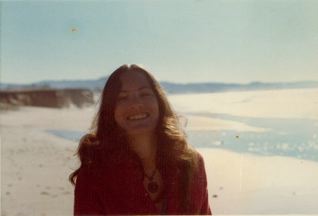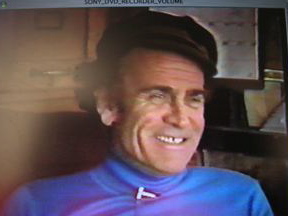 Left: Me, on the beach, at the time of the interview. Right: Pete Douglas
Left: Me, on the beach, at the time of the interview. Right: Pete Douglas
(Pete & I talked about the Miramar Beach Inn and how one owner closed the old bar and turned the building into an unsuccessful grocery store before it was again reincarnated as a bar/restaurant in the 1960s. From a tape transcribed by Linda Goetz, Coastside Secretarial).
Pete: Anyway, I’m drifting afar.
June: I just want to hear about it all. Feel free. No one seems to really know the chronological order of what happened on this street, Mirada Road. Where did you come from?
Pete: Los Angeles.
June: And what were you doing down there, before you came here?
Pete: I was brought to L.A. when I was 9-years-old, from Arizona, by my mother and stepfather. I went to part of elementary school and high school in California. As soon as I was old enough to get on a bike, I really called Hermosa Beach my “second home”. And, incidentally, that is where when I was old enough to sneak into a bar, at age 17, I went to hear jazz.
We ended the big band era in the late 1940s and started a movement of jazz again with small groups often taking over the back end of bars playing for nothing, if necessaqry, just to have a place to play…small groups, modern jazz in the back of bars–and there were always several Hermosa Beach bars, mainly the Lighthouse…
After the army, I went back to college, El Camino Junior College, in or near L.A., southwest L.A., near Inglewood.
When I finished college, I knew I had to get out of L.A. The smog and everything. This was the early 1950s. So I looked for any way to transfer to college up north. I made the first step to Santa Barbara. I transferred as junior to Santa Barbara in 1953 and graduated two years later in ’55.
June: And your major?
Pete: Sociology.
June: That’s my major, too.
Pete; What do sociology majors do?
June: They get lost.
Pete: That’s a crazy breed. Well, of course I didn’t find work in Santa Barbara. But then I had Linda (his first daughter) on the way. I had to get a job and on the bulletin board there was a job as an Assistant Field Director for the American Red Cross up in northern California. They ended up putting me at Travis Air Force Base, Vacaville. That’s how I moved down here.
Well, anyway, in the simmer of 1955 I graduated, went directly to Vacaville, lived there for a year-and-a-half, I think, and thought I was going to get a job in Marin. I had my eye on Marin County. I didn’t give a s— about the job; I was just trying to find the area I cared to live in.
And, you know, in Sausalito, you could have had a store front for a song. In the 1950s people were looking for interesting places. There was the Bridgeway and the vacant storefronts and I didn’t know what I was going to do with one of them.
I figured if I could get a job in Marin County then I would start working in Sausalito. Drum up something, i didn’t know what. But it didn’t pan out. The job didn’t materialize and I had moved to San Rafael.
Then I got a letter, word must have gotten out in the industry, and as usual the government was expanding and I got a letter from an administrator: ‘come and help us, saying he wanted to talk to me about a job.
I badly needed a job. The Red Cross was going to send me to Alaska, or quit. So that’s how I came to San Mateo County in early ’57. Came to this county, took the job as a probation officer.
